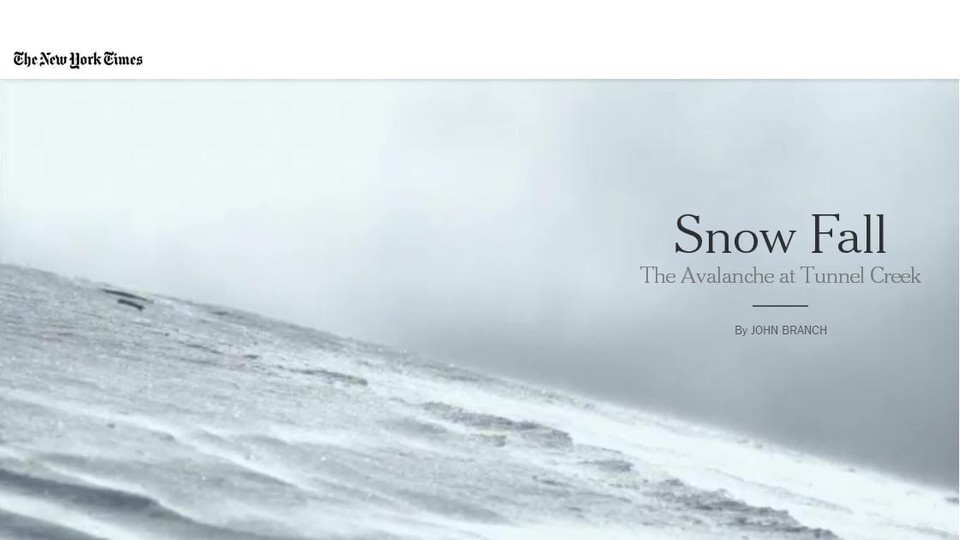Elevating your Brand Through the Power of Visual Storytelling

Posted By Colleen Irish on January 22, 2013
With the Golden Globes behind us, and the Oscars just around the corner, it’s time to place bets on which film productions are most awards-worthy. One visual story you may not be familiar with, John Branch’s “The Avalanche at Tunnel Creek,” is a must-see and, interestingly enough, a must-read. However, you won’t find this story among Academy Awards nominees. This ingenious production is hosted on The New York Times’ website, where it’s being shared at a furious clip via social media and being heralded as a leading example of the future of storytelling. As you’re thinking about ways to make your brand truly stand out on the Web and deliver meaningful content that resonates emotionally with your customers, you might want to grab a bag of popcorn, pull up your chair and read on.
Our Siskel and Ebert version of The Avalanche at Tunnel Creek
To be commended as a riveting documentary, Branch’s innovative reading experience -- presented in a mixture of interactive narratives of journalism, video and computerized graphics – emotionally moves and captures its audience from the start.
Branch’s descriptions are so vivid that the reader feels ready to strap on his/her own pair of skis to join this chosen group on what first looked to be an appealing and exciting backcountry adventure. Branch describes Tunnel Creek as a serendipitous junction of place and powder for skiers and snowboarders alike with open meadows framed by thick trees and steep gullies that drain to the valley floor and into a small gorge called Tunnel Creek. Through the use of simulation software, these powerful descriptions come to life in panoramic views of the glorious mountainside.
With a running (and reading) time of around 60 minutes, the story is split into 6 short episodes or chapters, combining short videos of personal interviews and live footage from the actual day. Branch takes great care to reveal enough information about each of the 16 skier’s personal lives, providing the reader with an emotional connection every step of the way.
Telling your Story Visually With Impact
The New York Times is a great example of how visual storytelling that truly evokes emotions can have a lasting effect on your target audience. Its genius display of visuals provides insights that a print story alone could never deliver.
More and more businesses are recognizing that it is essential to deliver meaningful, relevant content that appeals to and engages the emotions of their constituents. The challenge is how to tie feelings to products or services within the realm of visual storytelling.
You might be thinking: “My corporate story is no thrill-a-minute avalanche story, and I don’t have nearly the budget the Times lavished on this feature. Can visual storytelling still work for me?” The answer is emphatically yes. The trick is to first consider your brand’s story from an emotional and visual perspective, and then assemble your narrative in a way that draws out those elements. At which point in the buying process do customers feel deep emotion surrounding your product?
Sometimes it’s a strong emotion that drives them upfront – for instance, parents buy child-protection software for their computers out of fear of cyber-stalkers. Or your customers’ emotional payoff may come after purchase, like the glorious, free feeling of hitting the open road in a new car. Even B2B companies can tap into the power of emotional connection. Showing how a company solves a problem can strike an emotional chord with its customers.
Next you need to think visually. Imagine assembling a scrapbook of your company’s story, brand(s) and vision. What pictures really capture what you’re all about, while eliciting the emotional response you want? Similarly, when you think of the personalities that animate your team, who can “speak from the heart” and thus stands out as a perfect “face” for different facets of your organization? Those folks would make great video interviews. Finally, almost any product benefits from a visually driven explanation of how it works and why it’s great for consumers. The “How X Works” story of your brand makes an ideal candidate for an animated short video. Nearly all of these content pieces can be produced affordably – in fact, images, photos, screencasts and webcam videos can be professionally produced at minimal cost.
We’re going to continue to see more of these types of visual experiences from companies in an effort to remain competitive, stimulate new viewers and sustain existing ones. So whether it’s through video, infographics, SlideShare, or software simulation, it’s time to start moving beyond text, and to communicate your story in an emotionally charged visual language that is informative and can even entertain—just like the films up for this year’s Academy Awards.



